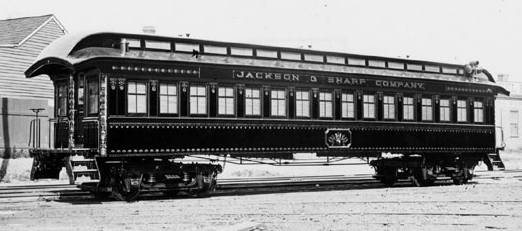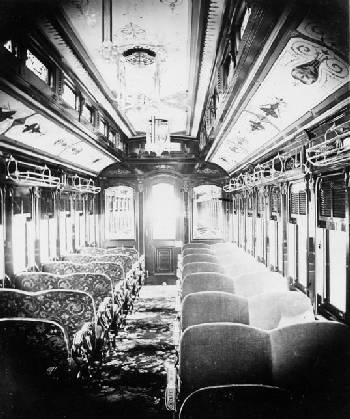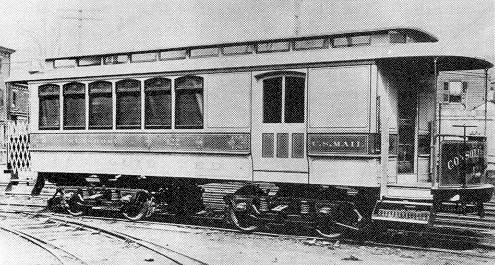Builders of Wooden Railway Cars ... and some of other stuff
Jackson & Sharp - Page 2
In 1882, Job Jackson took over the management of the Woodruff Sleeping & Parlor Coach Company—the company founded by Jonah Woodruff after he and his brother had been forced to lease their Central Transportation Company to George Pullman—and afterward all Woodruff cars were built by Jackson & Sharp.
Exterior (above) and interior (below) of Jackson & Sharp’s Gold Medal winner at the 1883 Chicago Exposition of Railroad Appliances.
Between 1884 and 1888, Jackson & Sharp sold 50 new cars to Woodruff at a cost of more than $594,000. It was a good deal for Jackson & Sharp, but together with declining revenues, left Woodruff in dire financial straits. The only answer seemed a merger with one of Pullman’s other competitors, the Mann Boudoir Car Company, which was also having financial problems.
In September 1888, the Union Palace Car Company was formed, with capital of $3 million. Union immediately bought out the Woodruff and Mann companies, paying off their indebtedness to Jackson & Sharp and to the other Wilmington builder, Harlan & Hollingsworth, in the process. Union inherited a fleet of 181 cars operating on 5,500 miles of railroad, with prospects of further contracts. The December 1888 issue of the Official Railway Guide startled the railroad world (and most of all George M. Pullman) with the announcement: “Union Palace Car Co.... will commence operating SLEEPING AND PARLOR CARS on about 15,000 miles of railroad in January 1889.”
It did not take Pullman long to eliminate this new competition. In January 1889, just three months after its founding, the Union Palace Car Company was purchased by Pullman for $2.5 million.
But back to Jackson & Sharp...
Hard times came again with the financial panic of 1893, but they were not as bad as in 1873, nor did they last as long. By the late 1890s, Jackson & Sharp was turning out about 400 cars per year.
Electric car built ca. 1899 for Consolidated Railway of Charleston, South Carolina. Jackson & Sharp manufactured even the motor trucks. In 1901, Job Jackson died and the company was acquired by American Car and Foundry, where it became their Wilmington Works. At that time it employed about 1,500 men.
American Car & Foundry used the Jackson & Sharp plant in Wilmington primarily for construction of railroad cars for export orders until around 1920.
During the 1st World War the Wilmington plant produced minesweepers.
From the end of the 1st World War until 1938, the plant was kept open by building small pleasure boats and an occasional motor bus. It built its last rail car about 1931.
During the 2nd World War, the Wilmington plant built 10 mine sweepers for the British navy, two salvage vessels for the U.S. navy, four “net-layers” for the U.S. and British navies, 8 landing barges for the U.S, army and more than 450 for the U.S. navy, together with many other lesser vehicles of different types.
But as the war wound down, so did the Wilmington plant. It was closed about 1945.
For More Information —
Hoffecker, Carol, Wilmington, Delaware—Portrait of an Industrial City, 1830-1910. Charlottesville, VA: University Press of Virginia, 1974.
Online —
A Brief History of the Jackson & Sharp Company, Car and Ship Builders, 1863 - 1950. (Excellent and comprehensive article.)
Online points to begin in-depth research —
“Jackson & Sharp Car Company and American Car & Foundry Company Records, 1884 - 1948.” National Museum of American History (Smithsonian Institution). Online description of holdings.
Back to page 1


